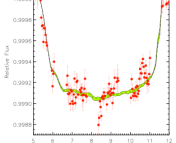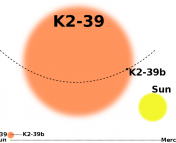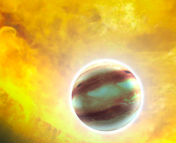Title: Doomed Worlds I: No new evidence for orbital decay in a long-term survey of 43 ultra-hot Jupiters
Authors: Elisabeth R. Adams, Brian Jackson, Amanda A. Sickafoose, Jeffrey P. Morgenthaler, Hannah Worters, Hailey Stubbers, Dallon Carson, Sakhee Bhure, Stijn Dekeyser, Chelsea Huang, Nevin N. Weinberg
First Author’s Institution: Planetary Science Institute, Tucson, AZ, USA
Status: Accepted for publication in The Planetary Science Journal [open access]
Ultra-hot Jupiters: Fleeting Beauties?
Ultra-hot Jupiters are gas giants orbiting close to their stars, with orbital periods less than roughly three days. Because these planets are large and close-in, they produce large signals, making them promising targets for detection and characterization. But, you know what they say: all good things must come to an end. These planets are expected to experience large tidal effects from their stars, resulting in a loss of angular momentum, orbital decay, and, eventually, the star engulfing the planet.
Several lines of evidence support the picture that ultra-hot Jupiters are subject to orbital decay over long timescales. For instance, stars hosting hot Jupiters tend to be younger than the average exoplanet host star, and ultra-hot Jupiters are rarer around older host stars. A recent paper even reports a direct detection of a planetary engulfment event from the sudden, short-lived increase in brightness of a faint star. While this evidence paints a compelling picture, it is difficult to estimate how quickly we expect ultra-hot Jupiters to experience orbital decay given theoretical uncertainty in stellar tidal effects.
Keeping Time: Working Hard or Hardly Working?
Because we expect orbital decay to occur and we know of thousands of transiting exoplanets, some of which have been observed for decades, several teams have searched for orbital decay and found two promising detections: WASP-12 b and Kepler-1658 b. Searching for orbital decay relies on the detection of transit-timing variations. This is when a planet passes in front of its star along our line of sight earlier or later than expected. There are many sources of transit-timing variations in addition to orbital decay, including precession, perturbations from companion planets or stars, or acceleration of the host star towards Earth.
Let’s say we observe the transit of a planet at time t = 0 and know its period P. We expect to observe transits at time P, 2P, 3P, etc. In the case of orbital decay, the period of the planet is getting smaller as time goes on, meaning we need to factor in an additional quadratic term encoding the rate at which the period shrinks. Then, to detect a statistically significant signal of orbital decay, we need to show that the quadratic model fits the data better than the constant-period linear model. The authors of today’s paper attempt to do exactly this but with an impressive level of care and attention to detail.
This science depends upon accurate and precise measurements of transit times for each planet in the authors’ sample, most of which have been observed by several teams with various instruments and methodologies over years or decades. Moreover, each transit time must be reported in one unified timing system (typically BJD_TDB). Not every transit observation properly identifies its timing system or accurately converted between timing systems, meaning any historical inaccuracies complicate such studies.
Statistical Methods: Comparing Models
The authors of today’s paper compile transit times for 43 ultra-hot Jupiters and take new transit data for six of those planets to extend the temporal baseline of observations. To assess whether the linear (constant period) or quadratic (changing period) model fits the data better, the authors use the Bayesian Information Criterion, a model selection criterion that awards a good fit but penalizes additional parameters to avoid overfitting. The authors calculate the difference in the BIC (ΔBIC) between the linear and quadratic models, with a larger ΔBIC suggesting the quadratic model is preferred.
The authors additionally perform a variety of steps to ensure the quality of the data. They perform omit-one tests, where individual transit times are removed from the analysis and flagged if they alter the ΔBIC result by more than 25%. This step is essential since one time recorded inaccurately or in the wrong system could result in a spurious detection of orbital decay. The authors additionally perform a “rescaling test,” where the error bars are scaled up to account for unrealistically low error bars in reported transit times.
Results

As shown in Figure 1, four planets out of the sample of 43 had a ΔBIC above the detection threshold, including WASP-12 b, which had been previously found to show orbital decay. The authors measure WASP-12 b’s period to be shrinking by 30 milliseconds/year, matching previously reported values. The planets WASP-121 b and WASP-46 b show tentative period increases, but these results are highly dependent on one or a few data points, warranting further observations. The planet TrES-1 b has prior tentative claims of its period decreasing, and the authors find a tentative period decrease of 18 milliseconds/year. However, this rate of period shrinkage suggests stellar tidal effects that would differ greatly from theoretical predictions, perhaps suggesting a cause of period decrease other than orbital decay.
Only one planet, WASP-12 b, was found to have a clear period decrease after rescaling error bars, as shown in the bottom panel of Figure 1. The authors predict that if other planets in the sample were decaying as rapidly as WASP-12 b, they could have found significant detections of period decrease in roughly half the sample. There is thus no evidence that orbital decay is common among ultra-hot Jupiters, which is possibly confounding considering the other lines of evidence that suggest ultra-hot Jupiters are subject to decay. Though patience is required, as time goes on, it will be possible to search for orbital decay around more planets at higher precision, helping us ascertain the ultimate fate of close-in planets.
Astrobite edited by Ivey Davis
Featured image credit: NASA/ESA/G. Bacon




